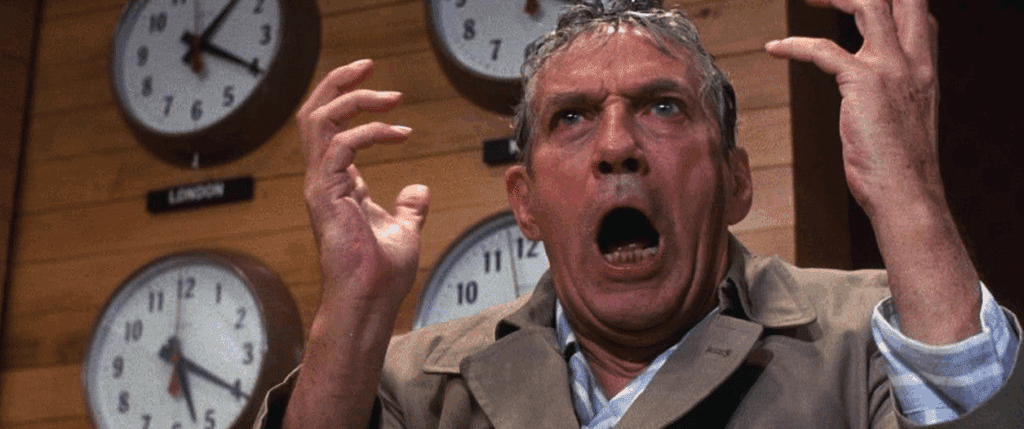
If you’ve watched a film or TV series that’s made you laugh and flinch at the same time, you’ve more than likely brushed shoulders with satire.
Satire is the sneaky ninja of storytelling; a laugh-in-your-face delivery system for ideas that might otherwise make an audience uncomfortable, defensive, or downright angry. And for screenwriters, satire is one of the most powerful tools in the toolkit. It’s a refreshing blend of comedy and confrontation that lets us critique society without ever raising our voices.
Whether you dream of writing the next Veep, Parasite, or something so subversive your parents will ask if you’re ‘doing okay,’ understanding satire is essential!
In today’s blog, we’ll be breaking down satire and help you to sharpen your comedic scalpel.
So, let’s get satirical…

What is Satire?
Satire is a narrative technique that uses humor, usually witty, ironic, exaggerated, or mocking, to highlight and critique societal issues, human stupidity, or institutional corruption.
The purpose of its punchline is to provoke thought and spark debate. Sometimes it might also inspire change on huge levels.
Unlike many forms of comedy, satire isn’t about laughs for laughs’ sake. Think of it as comedy with a conscience, amusing us while revealing uncomfortable truths. And great satire hits like a ton of bricks. One minute you’re having fun, and the next you’re wide awake and questioning the world you live in.
The best satire doesn’t merely point at a problem and say, “Look at that.” It says, “Look at that… and also look at yourself reacting to it.”

And it’s not just screenplays that satire is a huge part of. The Onion is one of America’s most satirical news sources, bringing the comedy to news media.
Satire vs. Parody vs. Spoof
Before we go any further, let’s clear up the genre confusion. Satire, parody, and spoof often get tossed together as if they’re different flavors of the same ice cream. However, they’re different desserts entirely.
Let’s break it down:
Parody
A parody imitates a specific work, style, or creator for comedic effect. Think Weird Al, or the way Scream lovingly ribbed slasher tropes.
Spoof
A spoof is broader and sillier. It’s an exaggerated send-up of an entire genre. Scary Movie, Airplane!, or anything that includes a man slipping on an unnecessarily placed banana peel for no reason.

Satire
Satire might use parody or spoof as tools, but its goal is critique. While parody says, “Isn’t this funny?” satire says, “Isn’t this true?”
To illustrate:
- Parody imitates Star Trek to poke fun at it.
- Spoof exaggerates space tropes in general.
- Satire uses a spaceship to make a point about bureaucracy, militarism, or the futility of leadership.
The Three Types of Satire
There are three classic categories of satire. If satire were a sporting event, these would be its divisions. And yes, they compete for dominance in your script whether you realize it or not!
Horatian Satire
Tone: Lighthearted, gentle, and playful.
Mood: “We’re all ridiculous. Isn’t that charming?”
Examples: The Office, Parks and Recreation, parts of Jojo Rabbit
Horatian satire doesn’t want to hurt anyone’s feelings. It’s observational, warm, and amused by humanity’s quirks. It pokes, nudges, and raises an eyebrow. It’s the kind of satire you could watch with your grandparents… mostly!
It’s ideal if you want your audience to reflect with a smile and not recoil.

Juvenalian Satire
Tone: Dark, bitter, and scathing
Mood: “The world is terrible and I am tired.”
Examples: Network, Parasite, Nightcrawler, and Dr. Strangelove’s harsher moments
Juvenalian satire is the real flamethrower of the genre. It is fueled by moral outage. It calls out corruption and demands change, often through brutal honesty or discomfort. While Horatian satire is more of a playful tease, Juvenalian is a roast written by someone who hasn’t slept in two years.

Menippean Satire
Tone: Intellectual, philosophical, and systems-level
Mood: “Let’s dismantle your worldview for a sec.”
Examples: Dr. Strangelove, South Park, Sorry to Bother You
Menippean satire attacks mindsets, ideologies, and attitudes. It says, “What if the entire way we think about this is flawed?” It’s cerebral satire, which is chaotic, surreal, and often hilarious.
This is the type for scripts that want to challenge how people think, not just what they think.

Satire is also a huge part of dystopian fiction and is key to some of the best stories like Animal Farm and Cat’s Cradle.
Screenwriting Satire
Satire requires precision. It’s not enough to write a joke and assume its meaning will shine through. Satire is about the intention under the joke. The why just as much as the what.
Here’s how to build that intention into your screenplay:
- Use Exaggeration as a Spotlight
Satire thrives on amplification. To expose flaws, scale them up until they’re impossible to ignore.
For example, if your target is bureaucracy, make the paperwork physically taller than the protagonist. Or if your message is about class division, exaggerate the wealth gap until the rich literally live around the clouds. - Write Subtext Like a Secret Weapon
Subtext in satire is where meaning hides. Characters rarely understand the point you’re making, but the audience does.
For example, a character brags about being ‘self-made’, while every scene shows others doing the work for them. The comedy is surface level; the critique lies underneath. - Let Action Reveal Hypocrisy
Don’t tell the audience what’s wrong. Instead, let the characters demonstrate it through behavior. A politician proclaiming transparency while whispering into a lobbyist’s ear? That’s satire gold.
- Make Dialogue Both Sharp and Purposeful
Satirical dialogue punches and slices crisp one-liners, double-meanings, ironic contradictions, and statements that reflect themes, not just plot.
- Anchor Absurdity in Truth
Satire must feel grounded in something real, even if the world you build is absurd. If the emotional or thematic core dissolves, the critique evaporates.
Example Analysis
To understand how satire actually functions on screen, not just as a literary device but as a cinematic strategy, it helps to study how masterworks across genres and sub-genres deploy humor, irony, visual metaphor, and tonal contrast.
Below are four examples from television and film, each using different techniques to deliver their social critiques. Whether you’re writing a zany political comedy or a surreal capitalist nightmare, these examples show how flexible and powerful satire can be.
1. Veep (2012-2019)
Armando Iannucci’s Veep is a seven-season scream into a political void. Its humor is relentless; machine-gun pacing, blistering insults, and characters so self-involved it’s a miracle they remember to walk upright.
Example: The “Shutdown Meeting” Scene
In a classic Veep moment, Selina Meyer’s team gathers to handle a looming government shutdown. It’s a moment that should be treated with gravity. Instead:
- Aides argue over whose fault it will appear to be.
- Selina worries about how she’ll look on camera.
- No one has actually read the bill.
Even the rhythm of the dialogue mirrors bureaucratic dysfunction; talking over each other, circular logic, and panicked strategizing that accomplishes nothing. Veep shows how satire can live inside character behavior.
2. Parasite (2019)
Where Veep uses words, Bong Joon-ho uses images. Parasite demonstrates how satire thrives in set design, camera movement, symbolism, and tonal shifts.
Example: The Birthday Party Climax
At the height of the film’s tension, the Parks throw a garden party. The wealthy guests sip wine under designer tents while:
- The former housekeeper’s husband hides in a bunker.
- The Kim family is collapsing under the weight of their desperation.
- A violent eruption of class rage is about to unfold on a manicured lawn.
The satire hits because the Parks can’t fathom anyone else’s suffering. They don’t see the chaos brewing behind the scenes, literally and metaphorically, because their worldview cannot process hardship. Their privilege becomes a form of blindness.
This is Juvenalian satire: it’s furious, tragic, and uncomfortably honest.
3. Dr. Strangelove (1964)
Stanley Kubrick’s Dr. Strangelove is the holy grail of Menippean satire. Instead of targeting individuals or institutions, it goes after the thought systems of militaristic logic, Cold War paranoia, and political bravado.
Example: “You Can’t Fight in Here! This Is the War Room!”
When President Muffley shouts this iconic line, the irony is explosive:
- The room built for war strategy is treated as a place of order.
- The leaders planning mass destruction can’t keep basic decorum.
- The absurdity exposes the childishness of political machismo.
Kubrick heightens the satire by grounding absurdity in realism with military jargon, sterile sets, and poker-faced performances. The style mimics the world it critiques, which makes the madness feel disturbingly plausible.
Example: The Doomsday Machine Reveal
When the Soviet ambassador mentions they built a device that will automatically destroy the world if attacked, but forgot to announce it publicly, the moment lands like a cosmic joke.
The satire is that humans build systems so catastrophically stupid that survival hinges on paperwork and PR strategies.
4. Sorry to Bother You (2018)
Boots Riley’s Sorry to Bother You is a fireworks display of Menippean satire. It’s bright, chaotic, and fiercely ideological. It skewers capitalism, labor exploitation, racial coding, and corporate culture with a blend of humor and surreal horror.
Example: The “White Voice” Telemarketing Scenes
Cassius Green’s rise in his telemarketing job begins when he adopts his “white voice”, a literal overdub that exaggerates a cheerful, carefree tone.
The satire works on multiple layers:
- Corporations prefer a fantasy version of employees.
- “Comforting whiteness” becomes a product.
- Workers must perform a false identity to survive.
The joke is funny, yes, but it’s also a scalpel dissecting how race and capitalism intertwine.
Example: The Equisapien Reveal
The moment Cassius discovers the corporation is turning workers into horse-people slaves is so surreal it feels like a fever dream, but thematically it’s sharp:
- Under capitalism, workers are treated as beasts of burden.
- Productivity is valued over humanity.
- Extreme exploitation becomes literalized in creature form.
The absurdity is a metaphor made horrifyingly tangible.
FAQs
Parody imitates a work or style for comedic effect. Satire uses humor to critique real issues. They can overlap, but satire always has a target outside the story.
Horatian satire is the most frequently used because it’s accessible, funny, and gentle enough for mainstream audiences. However, modern filmmakers are increasingly blending Horatian setups with Juvenalian payoffs.
Network (1976) is a quintessential example. It’s angry, direct, and uncompromising in its critique of media sensationalism. More modern options include Parasite or Nightcrawler.
Not necessarily. Jokes about politics aren’t automatically satire unless they’re used to expose or critique deeper issues, behaviors, or systems. A political joke can be just a joke.
Conclusion
Satire matters because it forces us to examine uncomfortable truths without shutting down. Humor opens the door; critique walks through it. Whether you’re writing a lighthearted workplace comedy or a dark allegory about the collapse of society, satire offers a way to challenge your audience while still entertaining them.
In a time when the world feels increasingly absurd, satire helps us see clearly. It exposes patterns, mocks hypocrisy, and invites us to imagine something better.
If you’re ready to tackle your own social critique, remember: a satirical screenplay is equal parts humor, insight, and craftsmanship. And if you need help organizing ideas, tracking themes, or structuring your screenplay, Celtx is built for writers like you.
Focus on your story, not your formatting.
Let Celtx’s Script Editor automatically apply all industry rules while you focus on the story.
Up Next:

Writing Subtext: How to Say More by Saying Less
Satire works best when there’s something meaningful under the surface. Dive into our guide to subtext to learn how to layer deeper meaning into every scene—and make your satire hit even harder.
